Patterned decorative ceramic tiles or azulejos are iconic in Portuguese architecture. In fact, I believe that Lisbon's azulejos are what make the city's architecture so unique and romantic.
The word azulejo has Arab origins and means small, polished stone (with one side glazed). Azulejos first came to Portugal in the early 15th century. Tile production ramped up in Lisbon in the second half of the 16th century.
Did you know that there is a museum dedicated to Portuguese tiles in Lisbon? The National Tile Museum was founded in 1965 and became a Portuguese National Museum in 1980.
The National Tile Museum (Museu Nacional do Azulejo) is admittedly a little challenging to get to since it's farther from Central Lisboa than many of the city's most popular tourist attractions.
Is Lisbon's National Tile Museum worth visiting? Spoiler alert... Yes! Read on to discover 25 pictures from the National Azulejo Museum that will make you want to visit.
How Much Does it Cost to Visit Portugal's National Tile Museum?
Getting to the National Tile Museum in Lisbon
We found that taking the bus is the easiest way to get to the National Tile Museum. Bus Numbers 210, 718, 742, and 759 stop at Igreja Madre Deus which is on the doorstep of the azulejo museum.
The Lisbon Metro Blue Line stops at Santa Apolónia Station which is about a 20 minute walk from the National Tile Museum.
Looking for other cool places to see Portugal's iconic tiles? Why not pay a visit to Queluz Palace with its tiled canal near Sintra?
Pictures of Lisbon's National Tile Museum
Dizzying Patterns
 |
| 1. Centuries old starburst tiles |
Religious History of the National Tile Museum
 |
| 6. Forest scene on the wall of Igreja Madre de Deus |
Make sure to take time to see the church (Igreja Madre de Deus) inside the National Tile Museum. It's made of gold and features very intricate Baroque architecture.
 |
| 7. Gilded panel on the wall of the church |
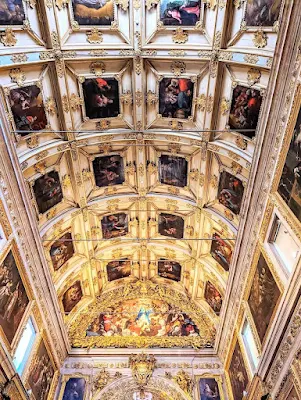 |
| 8. Oil paintings on a gilded church ceiling |
 |
| 9. Mother of God Church viewed from above |
You'll also find fabulous oil paintings by the Masters. The Madre de Deus Church closes from one to three every day. So make sure you get to the tile museum before 12:45 or after three, so you don't miss out.
Interior Courtyard and the Rise of International Competition
 |
| 10. Interior courtyard at the National Tile Museum |
In the courtyard on the second floor there are a number of interesting scenes including The Leopard Hunt. The most bizarre tile scene had to be The Chicken's Wedding. The scene literally depicts a chicken being driven in a coach. To its wedding...
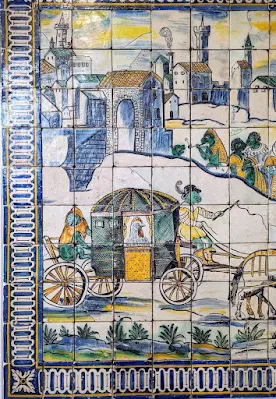 |
| 11. The Chicken's Wedding |
Many of the works in this area are by Manuel Francisco and date back to the mid-17th century. This was during a time period where competition from tile artists abroad in the Netherlands and Belgium was ramping up. This led the Portuguese azulejistas to up their game.
 |
| 12. The Leopard Hunt |
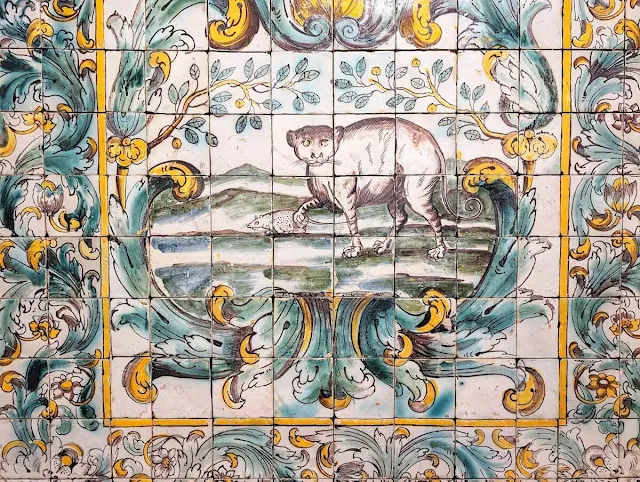 |
| 13. Animal on a field of green and yellow azulejos |
 |
| 14. Painted tile panel featuring men on horseback |
Between the late 17th and early 18th century, several tile panels were commissioned in the Netherlands. During this time period, we find a lot of blue tiles on a white background, much like you'd see on Delft tiles and pottery in the Netherlands.
In response to international competition, more talented painters began to work in Portuguese workshops. Their status elevated to that of artist and some even signed their tile panels as works of art.
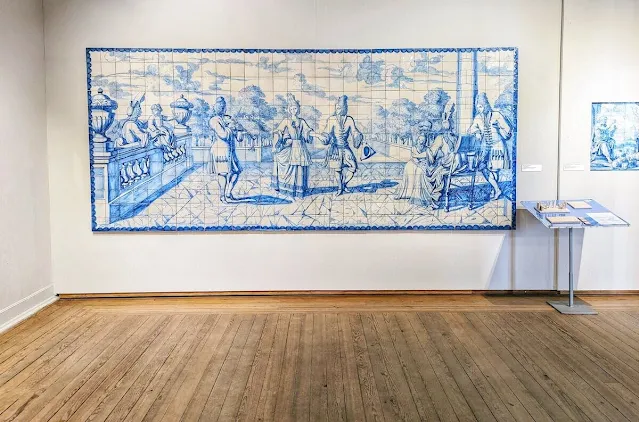 |
| 15. Blue and white tile panel featuring an aristocratic scene |
The early 18th century saw the rise of Portuguese tile painters like Gabriel del Barco, António Pereira, Manuel dos Santos, António de Oliveira Bernardes, and Policarpo de Oliveira Bernardes.
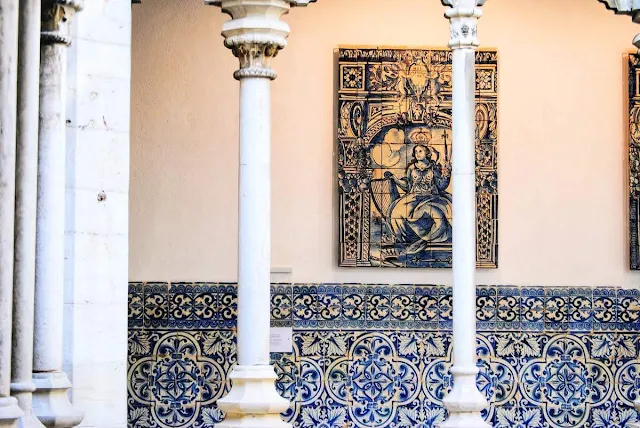 |
| 16. Tile painting and blue patterned wall tiles in the interior courtyard of the National Tile Museum |
The High Choir
The High Choir is one of the most impressive areas of the National Tile Museum. From here, you can look down upon the gilded church from above.
Check out often macabre religious relics which are encased in glass behind uncomfortable looking wooden seats. Look up at amazing oil paintings on the walls and ceiling.
 |
| 17. Gilded and painted ceiling of the high choir |
 |
| 18. Historic reliquary at the National Tile Museum |
Experience a sense of contrast in the modern art exhibits also on display here. When we visited, 25 pieces in white clay by Teresa Segurado Pavão were being shown off.
The works are pure white and integrate bones collected by the artist in the countryside and on the beach. The works sometimes incorporate elements of gold and silver.
An Exhibit of Modern Azulejos
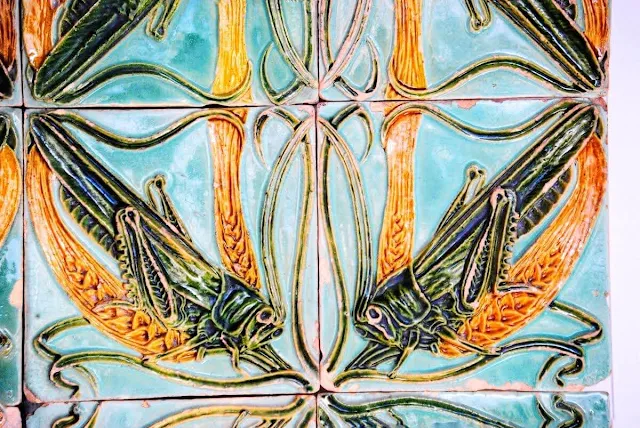 |
| 19. Modern azulejo panel featuring two grasshoppers |
.jpg) |
| 20. Modern tile panel featuring abstract art |
 |
| 21. Outdoor courtyard featuring a scene in worn blue and white tiles |
Cafe and Courtyard
 |
| 22. The cafe at the National Tile Museum in Lisbon |
Panoramic View of Lisbon by Gabriel del Barco
Don't forget to make time to see the panorama of Lisbon. The sequential tiled scene is 23 meters long and represents 14 kilometers of coast along the Tagus River from Algés to Xabregas.
The Panorama is the best record that exists today of what Lisbon actually looked like before the devastating earthquake of 1755.
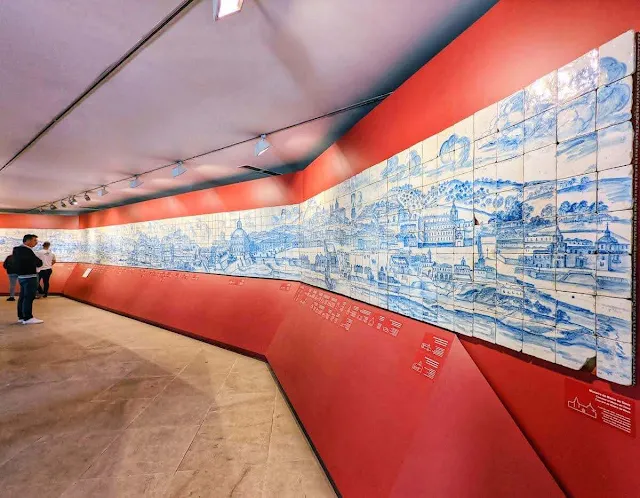 |
| 23. The Panoramic View of Lisbon viewed at full width |
Wander around and take flight like a bird flying over 18th century Lisbon. Take a look at some of the places you might recognize today like Belém Tower, Castelo de São Jorge and other Lisbon historic landmarks.
The Panoramic View of Lisbon is an important historical testimony to daily life in 18th century Lisbon. You can see buzzing Ribeira market, shipbuilding activities, and boats moving on the river.
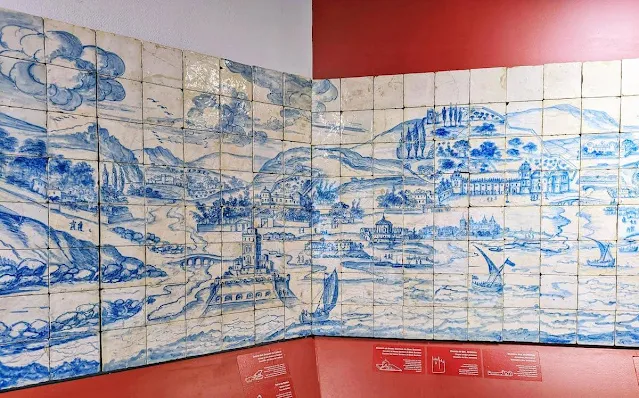 |
| 24. Corner panels of the panoramic view of Lisbon |
You'll also find the old neighborhood of Mocambo (now Madragoa) which was home to many of Lisbon's potteries. Keep an eye out for the potteries' smoking chimneys represented in the tiles.
Note: it's easy to miss the staircase that leads to the panorama. In my view, this was one of the more intriguing aspect of a visit to the National Tile Museum so make the effort to find your way here.
 |
| 25. Close up of a panel that is part of the panoramic view of Lisbon |
I hope you've enjoyed this virtual tour of the National Tile Museum and that you agree that it's definitely a Lisbon hidden gem that is worth exploring.








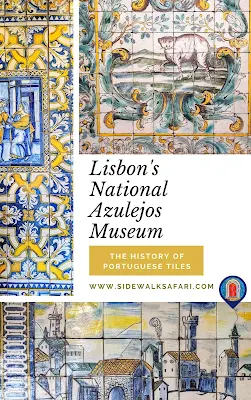

.jpg)
